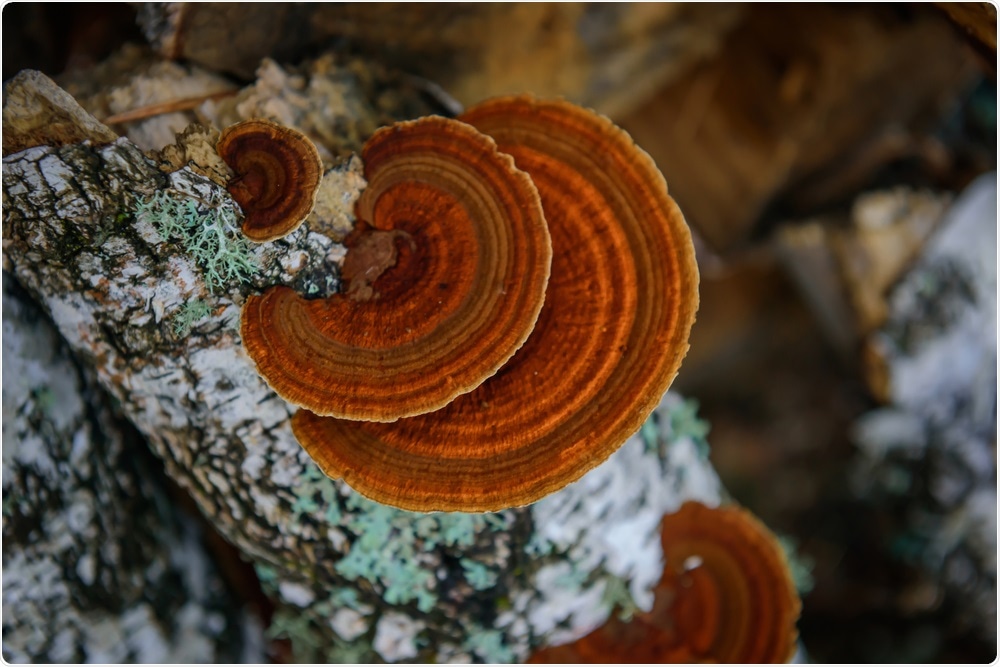The novel coronavirus disease 2019 (COVID-19) is caused by the severe acute respiratory syndrome coronavirus 2 (SARS-CoV-2). SARS-CoV-2 initially emerged from Wuhan, China, in late December 2019, and has since caused large-scale global outbreaks and over 4.9 million fatalities worldwide.
Study: Targeting SARS‐CoV‐2 with Chaga mushroom: An in silico study toward developing a natural antiviral compound. Image Credit: exebiche / Shutterstock.com
Background
SARS-CoV-2 infects the host cell through the interaction of the receptor-binding domain (RBD) of its spike (S) protein with the human angiotensin-converting enzyme 2 (ACE-2) receptor. Structural analysis has revealed that the RBD harbors conservative amino acids that primarily aid in the S protein recognition and binding to the ACE-2 receptor.
Currently, no definitive treatment has been discovered for COVID-19, while emerging SARS-CoV-2 variants of concern (VOCs) appear to escape immunity acquired through vaccination and prior natural infection. Therefore, scientists are exploring all possible antiviral options that range from direct therapeutics, natural extracts, immune boosters, as well as virucidal products.
Natural substances from herbs or mushrooms have been shown to possess potent antiviral properties. Chaga (Inonotus obliquus), a traditional edible mushroom with proven therapeutic value, contains biologically active substances like long-chain homopolysaccharide beta-glucan, galactomannan, and the unique terpenoid betulinic acid. Chaga extracts have natural anti-inflammatory and immune booster actions and are efficacious in combatting feline coronavirus and hepatitis virus.
About the study
A new study published in the journal Food Science & Nutrition examines the potential binding interaction of the beneficial components of Chaga mushroom with that of the SARS-CoV-2 RBD using molecular docking (MD) simulation and phylogenetic analysis. Here, the S protein of SARS-CoV-2 was targeted with the unique components of Chaga mushroom with the goal of developing a potent natural therapeutic regimen for inhibiting viral entry, boosting immunity, and reducing inflammation.
The study entailed retrieval of 202 global SARS-CoV-2 S protein amino acid sequences from Uniprot, which included a set of sequences from a bat, pangolin, and human samples involved in previous and recent outbreaks.
Multiple sequence alignment (MSA) assay and a generalized time-reversible amino acid substitution model were utilized to perform the phylogenetic analysis. Bootstrap replications of 1,000 values of the Nearest-Neighbor Interchange procedure were also used to estimate the robustness of each node, whereas the genetic distance was estimated using the maximum likelihood method.
Study findings
Phylogenetic analysis of SARS-CoV-2 S protein sequences was represented by an ML tree, revealing that SARS-CoV-2 originated in bats (outgroup), followed by intermittent transmission through pangolins and then by intermittent transmission through pangolins and then to humans. Amino acid sequence alignment depicted high conservativeness in the amino acid residues across all the samples.
A unique conservativeness in the amino acids 680-686 was noted in all the recent COVID-19 samples when compared to pre-2019 viral sequences. This observation suggested the role of amino acid conservation in SARS-CoV-2 evolution and pathogenesis.
Marked variations in the recent SARS outbreaks were observed when compared to previous outbreaks, which hinted towards a selective evolution of the RBD. In fact, several residues in the S1 C-Terminal domain (CTD) domain that have been reported to be key residues for binding of SARS-CoV-2 to human ACE-2 appeared to be positively selected and conserved.
Docking analysis revealed that Chaga mushroom components including beta glycan, galactomannan, and betulinic acid, which were bound to the S1 CTD residues of SARS-CoV-2, were involved in ACE-2-RBD interaction. Meanwhile, all ligand interacting sites were located in the S1 domain, which was a crucial target for the SARS-CoV-2 S protein.
Moreover, interacting sites were primarily hydrophilic in nature and suggested strong interaction with the ligands. Significant binding interaction could be observed of the S1 RBD of the SARS-CoV-2 with Chaga mushroom components. All ligand interacting sites were precisely attached within the carboxy-terminal domain of the RBD and included amino acid residues that were found to aid viral entry in a conservative manner.
Implications
Chaga mushrooms appear to have similar effects by various interactions and through their ability to modulate the virus-host cell interaction. The benefits of the Chaga mushroom could be due to its unique composition, which can facilitate the specific targeting of the S1-RBD of SARS-CoV-2. In addition, being a natural compound, the use of Chaga mushroom in appropriate doses is devoid of side effects.
Furthermore, Chaga mushroom use enhances specific innate immunity and assists in lowering proinflammatory cytokines like interleukin-6 (IL-6), IL-10, tumor-necrosis factor α (TNF-α), and monocyte chemoattractant protein (MCP). This property assists in reducing the case fatalities of COVID-19 imposed by the “cytokine storm,” which leads to uncontrollable amplification and recruitment of inflammatory cytokines and immune cells to combat the infection, resulting in organ damage and death.
The current study results revealed that Chaga mushroom components demonstrate strong binding interaction with the S1-carboxy-terminal domain of the SARS-CoV-2 RBD; thus, this natural product shows promise in interacting with the viral spike protein.
It was inferred that the Chaga mushroom could prove to be a health-promoting booster in severe COVID-19 cases, particularly in patients who develop excessive inflammation. Therefore, laboratory-based studies and clinical trials could reveal prospects for the development of natural antiviral therapeutics.
